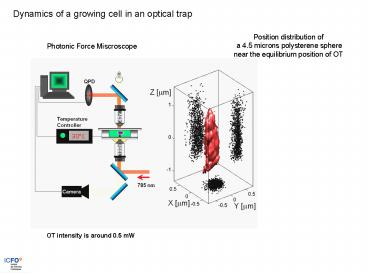Dynamics of a growing cell in an optical trap
1 / 9
Title:
Dynamics of a growing cell in an optical trap
Description:
Forward scattered light of a trapped heat-treated yeast cell ... cytoskeleton is crucial for a complete understanding of biochemical. processes in living cells. ... –
Number of Views:35
Avg rating:3.0/5.0
Title: Dynamics of a growing cell in an optical trap
1
Dynamics of a growing cell in an optical trap
Position distribution of a 4.5 microns
polysterene sphere near the equilibrium position
of OT
Photonic Force Miscroscope
OT intensity is around 0.5 mW
2
A living yeast cell in the trap
30 min
3
Forward scattered light of a trapped heat-treated
yeast cell
4
An accurate physical picture of the
viscoelasticity and motion of the cytoskeleton
is crucial for a complete understanding of
biochemical processes in living cells. The
viscoelestic properties of cells arise from a
network of protein filaments driven by
specialized motor proteins. A cell is thus a
nonequilibrium soft material those fluctuations
are actively driven. Unlike the thermal
fluctuations in an equilibrium material, the
amplitude and spatial distribution of active
fluctuations can be controlled via biochemical
signaling pathways , perhaps allowing the cell to
locally adjust its mechanical properties to suit
its needs. Flow cytometry is a technique in
which such measurements are made while the cells
or particles pass through the measuring apparatus
in a fluid stream. Most of the developed
technique for flow cytometry are based on the
reverse scattering problem. On the other hand
the scattering is a basis of optical trapping.
We study dynamics of living cells using a
time-of-flight method. This method is widely
used in different area of physics as atom
cooling by measuring temperature of cooled
atoms, in infrared spectroscopy and mass
spectroscopy. In this case one monitors the
trapping dynamics of the particle with given
optical properties and radius while it is being
drawn into the focus of the optical trap by
time-resolve detection of the particle position
during a trapping event. Practically the force
calibration based on the trapping dynamics is
carried out by flipping the particle between two
adjacent laser traps, realized by two focused
laser spots, which can be switched on and off
individually, and simultaneously monitoring the
particle position.
W. Singer and S. Bernet and N. Hecker and M.
Ritsch-Marte, Three-dimensional force
calibration of optical tweezers, J. Modern
Optics, 47, 2921-2931 2000 F. Ignatovich and A.
Hartschuh and L. Novotny, Detection of
nanopartcles using optical gradient forces, J.
Modern Optics, 50 1509-1520 2003 ,
5
Experimental setup
x
QPD
y
z
6
Experimental setup
7
Experimental traces
z
x
y
8
Experimental traces for a 4.5 microns polysterene
sphere
9
Experimental traces for a yeast cell































